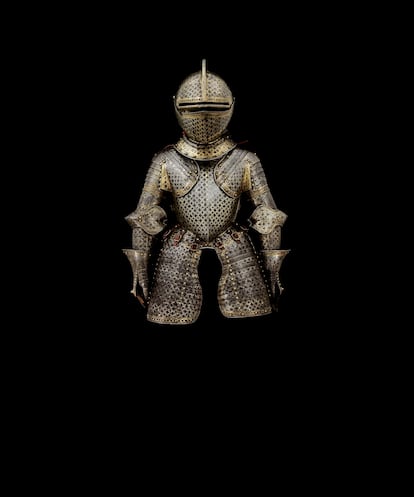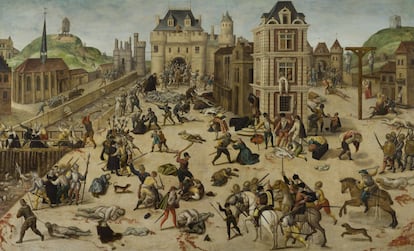The St. Bartholomew’s Massacre: The apotheosis of violence in the Wars of Religion in France
An exhibition at the Army Museum in Paris recalls the conflicts that shook the country in the 16th century and offers lessons for the present

The 16th century was the era of the Renaissance and the great discoveries, which broadened humanity’s horizons and knowledge. But it was also one of the most violent and terrible times in the history of Europe, marked by the wars of religion and identified above all with the St. Bartholomew’s Day Massacre. On the night of August 23-24, 1572, a massacre of Huguenots (as Protestants were known in France) began in Paris. The event then unleashed a summer of horror in numerous French cities. Ten thousand Protestants were killed in a very short period. It is an episode immortalized many times in fiction – by Marlowe, in The Massacre at Paris; Heinrich Mann, in The Novel of Henry IV, and especially by Alexandre Dumas in Queen Margot — and that historians continue to investigate in search of an answer to explain such an outburst of hatred.
An exhibition at the Army Museum in Paris recalls that violent period, during which at least eight wars were fought between Catholics and Protestants in France. The tragedy of those conflicts is that the situation that separated the two was hopeless. There was no way to achieve peace, unless the conception of the state changed, and the subjects could have a religion different from that of their king. People were hated and killed for who they were and could not stop being, even if they converted. As with the Jews, changing one’s religion was always shrouded in suspicion.
In a war-torn continent, echoes of that period of sectarian violence that divided the people in insurmountable ways will inevitably resonate. The parallels that historians find are not so much based on the different religions that coexist in the same European territory today, as on the panorama of a society broken by increasingly deep fractures, as had happened since the Reformation between Catholics and Protestants. Although, in theory, the edict of Nantes in 1598, which can be seen in the exhibition (open until the end of July) ended the conflict because it accepted the existence of the Huguenots, it was later revoked, and the 17th century was even worse than the 16th, because it also coincided with a period of cold weather of the so-called Little Ice Age.

“We were interested in the wars of religion because in the museum we had the armor that belonged to the main belligerents in those conflicts. That’s how the idea was born,” explains Laetitia Desserrières, one of the four curators of the exhibition, entitled La Haine des clans. Guerres de Religion, 1559-1610 (Hatred of the clans. Wars of Religion) and curator of the collection of drawings at the Army Museum. “But when we finished the exhibition, we realized that there are many echoes in our society. Then as now, propaganda was of enormous importance. Even then, fake news was circulating, spreading with extraordinary rapidity.”
The exhibition ends with a video by Antoine Arjakovsky, co-director of the Department of Political Research and Religions at the Collège des Bernardins, which brings visitors back to the present: “Wars of religion are possible in the 21st century insofar as there is the same underlying problem that we knew in the 16th century, that is, a change in political theology. Right now, we see what is happening with Russia, which recalls the imperial project with the harmony between the power of the tsar, who rules over bodies, and the power of the Orthodox patriarch, who rules over souls. And, in front of them, a model of the nation state, which holds that neither language, nor history, nor religion can separate a nation because it is united by something much more important: moral conscience. The Ukrainians are defending their right to have formed a state based on the dignity of all human beings.”

At the epicenter of the exhibition is the St. Bartholomew’s Day Massacre in a room that recreates, through the giant copy of a painting belonging to the Musée cantonal de Beaux Arts de Lausanne, the peak of the voilence and that immerses the visitor in the killing frenzy that shook the French capital in just a few hours. The work is entitled The Saint Bartholomew’s Day Massacre and its maker was François Dubois. It is the only known painting by this painter, a Huguenot from Amiens, survivor of the massacres, who had to take refuge in Geneva to escape that summer of violence and is one of the few contemporary representations of the murders. As Le Monde recently recalled in the chronicle of the exhibition, “of those wars of religion, people remember a single episode above all: that massacre.”
Before entering the room, two showcases display dozens of weapons, all different, all authentic, which point to the visitor and brutally illustrate the violence of the time, a time in which a deadly technological revolution also began with the general of the use of firearms. A poster explains what the visitor will find: “The second half of the 16th century is a period of violence during which murders and killings multiply. Although the word was forged before the 16th century, the term massacre became widespread at that time.”
“Our idea was to immerse the viewer in violence,” explains Desserrières. “Our scientific board had asked us to treat the killing differently. It’s the best-known episode, but we wanted to dispel some myths. It is a massacre in which the king was involved. It marked, to some extent, the end of an era of mass murder and opened a reflection on real power and the notion of obedience. People began to wonder about the nature of the monarch’s power and blind obedience, and also about the right to rise up.”

The historian Jérémie Foa, author of a book that has made a big impact in France, Tous ceux qui tombent: Visages du massacre de la Saint-Barthélemy (All who fell. Faces of the St Bartholomew’s Day Massacre), has thrown a new interpretation of the mass murder. His vision is that it was not so much a massacre organized from power — in addition to King Charles IX, his mother, Catherine de Medici, has always been pointed out as the chief instigator — but that it was a “massacre of proximity”: neighbors murdered their neighbors, even their relatives. In different interviews and interventions, Foa has compared it with what happened in Bosnia or Rwanda at the end of the last century.
After thorough research in different archives and documents, Foa discovers that the murderers were often people who were very close to their victims. “Protestants were used to being persecuted by people they knew and, therefore, on the night of August 23 to 24 they opened the door thinking that they were simply going to be imprisoned, as had happened other times,” he explains in a video that can be seen in the room. In no case did they defend themselves collectively, thinking that it would be just another act of persecution. In his book, his description of the savage violence against men, women, and children, as well as torture and betrayal within families is impressive. And he describes murders like those committed by Thomas Crozier, a fanatical Catholic, who boasted in the following days that he had murdered 400 Protestants with his own hands. It may be true.
In his analysis of Dubois’s painting through which the massacre is represented, Foa makes an important clarification, which contradicts the most widespread image of what happened those days at the end of August in Paris and the one that popularized the novel by Alexandre Dumas. “The painting shows how the killings take place in public, in broad daylight. However, the latest research shows that most took place in prison, behind the walls, away from the gaze of Parisians,” he explains.
Leaving the exhibition, one visitor says to another, “It’s a bloody story.” “Bloody,” replies his companion. Moreover, it is a not-so-distant history which has still not been fully studied or understood.
Sign up for our weekly newsletter to get more English-language news coverage from EL PAÍS USA Edition
Tu suscripción se está usando en otro dispositivo
¿Quieres añadir otro usuario a tu suscripción?
Si continúas leyendo en este dispositivo, no se podrá leer en el otro.
FlechaTu suscripción se está usando en otro dispositivo y solo puedes acceder a EL PAÍS desde un dispositivo a la vez.
Si quieres compartir tu cuenta, cambia tu suscripción a la modalidad Premium, así podrás añadir otro usuario. Cada uno accederá con su propia cuenta de email, lo que os permitirá personalizar vuestra experiencia en EL PAÍS.
¿Tienes una suscripción de empresa? Accede aquí para contratar más cuentas.
En el caso de no saber quién está usando tu cuenta, te recomendamos cambiar tu contraseña aquí.
Si decides continuar compartiendo tu cuenta, este mensaje se mostrará en tu dispositivo y en el de la otra persona que está usando tu cuenta de forma indefinida, afectando a tu experiencia de lectura. Puedes consultar aquí los términos y condiciones de la suscripción digital.
More information
Últimas noticias
EU’s prestige at stake with proposal to fund Ukrainian war effort with Russian assets
Mustafa Suleyman: ‘Controlling AI is the challenge of our time’
Venezuela breaks energy agreements with Trinidad and Tobago due to alleged complicity with the US
The murder of Michele and Rob Reiner: A tale of horrific days in Hollywood
Most viewed
- ‘El Limones’ and the growing union disguise of Mexican organized crime
- Christian Louboutin: ‘Young people don’t want to be like their parents. And if their parents wear sneakers, they’re going to look for something else’
- ‘We are dying’: Cuba sinks into a health crisis amid medicine shortages and misdiagnosis
- A mountaineer, accused of manslaughter for the death of his partner during a climb: He silenced his phone and refused a helicopter rescue
- The low-cost creative revolution: How technology is making art accessible to everyone










































